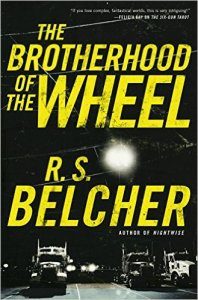Russell Letson reviews Alastair Reynolds
Slow Bullets, Alastair Reynolds (Tachyon Publications 978-1-61696-193-0, $14.95, 192pp, tp) June 2015. Cover by Thomas Canty. [Order from Tachyon Publications, 1459 18th St. #139, San Francisco CA 94107]
 Alastair Reynolds’ Slow Bullets might be considered ‘‘military’’ SF, since its narrator and most of its characters are soldiers in a now-ended interstellar war, and much of their behavior is conditioned by their experiences in that conflict, but those conditioning experiences are background to a different kind of story. The narrator, Scur, awakens from hibernation aboard a starship that has emerged from an interstellar jump, apparently lost, with crucial systems damaged and decaying and crew and passengers in chaos. This situation unfolds after a prologue in which Scur recounts her wartime capture and torture during a ceasefire but before everyone actually stopped fighting. Scur’s psychopathic tormenter, Orvin, was prevented from killing her outright, and she promised him, ‘‘I’ll find you and make you remember this.’’
Alastair Reynolds’ Slow Bullets might be considered ‘‘military’’ SF, since its narrator and most of its characters are soldiers in a now-ended interstellar war, and much of their behavior is conditioned by their experiences in that conflict, but those conditioning experiences are background to a different kind of story. The narrator, Scur, awakens from hibernation aboard a starship that has emerged from an interstellar jump, apparently lost, with crucial systems damaged and decaying and crew and passengers in chaos. This situation unfolds after a prologue in which Scur recounts her wartime capture and torture during a ceasefire but before everyone actually stopped fighting. Scur’s psychopathic tormenter, Orvin, was prevented from killing her outright, and she promised him, ‘‘I’ll find you and make you remember this.’’
The lost ship is the Caprice, and the surviving crew and passengers are faced with multiple challenges: stabilize the ship’s infrastructure and their own messy and violent interactions; figure out where and when they are; make their way back to civilization. Sorting out the social part comes first, and it’s as tricky as repairing the hardware, since the human cargo of the Caprice is largely made up not of ordinary returning soldiers but ‘‘dregs’’ of various kinds: ‘‘[t]raitors, mercenaries… civilian criminals. Rapists, murderers, black marketeers. A shipful of headaches.’’ Scur does not believe that she is any of those things, and she, along with a meek but resourceful crew member named Prad, become central to the efforts to establish order and get the ship operational. When Scur realizes that Orvin is aboard, she has another, personal goal: to find him and take revenge. But first she and the rest of the marooned have to get themselves and the ship in order. The survivors’ problems are made worse by the gradual, irreversible decay of the ship’s data systems, which are losing both operational information and cultural libraries, so that eventually the Caprice will be lost in more than space and time.
The whole situation is microcosmic and metaphorical nearly to the point of allegory: to recreate a polity after a destructive war, while navigating class distrust, old hatreds, religious rivalries, and individual feuds, and to preserve multiple cultural heritages in danger of vanishing. The ‘‘slow bullets’’ of the title are particularly symbol-laden – literally. Each soldier’s body contains one of these devices, and while they can be programmed to be weapons (Orvin intended to use one to kill Scur), their primary job is to hold a soldier’s official military records and personal data – her heritage, her family history, her identity.
The immediate problems of maintenance and social order are manageable, but determining where the Caprice has wound up drops the survivors through a series of increasingly deep trapdoors and deposits them in a situation that transforms and reframes their efforts. This, along with the solution to the data-decay problem and the outcome of Scur’s eventual showdown with Orvin, point the story in an entirely new direction and towards a set of resolutions that one would not have expected from the first chapters. We wind up in a place far removed from ‘‘military SF,’’ even though some of that subgenre’s themes and concerns generated the initial situation. Slow Bullets finally addresses a set of questions about what it takes to rebuild a damaged society: what is worth saving, what can or should be jettisoned, how to choose a new direction, and how one’s humanity might be reshaped in order to make that all happen. It’s an unexpected and satisfying destination for what seemed at first to be a straightforward melodrama of survival and revenge.






